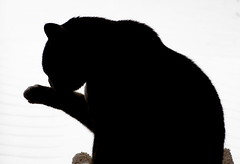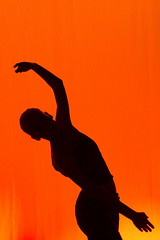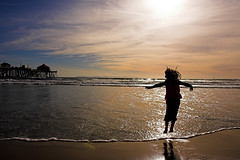Silhouettes were a popular art form in the early 1800s. Film did not yet exist, but skilled artists could look at subjects and then cut out remarkable likenesses using black paper and sharp scissors. People had silhouettes made of loved ones and framed them like portraits. The fad declined in popularity after cameras became more universally available.
Still, silhouetted images can be striking. They are also remarkably easy to create with digital cameras and worth mastering. If overdone, they can be tiresome, but when well done they can be fun.
A silhouette focuses attention on the outline of the person, animal, or object. The interior is either black or else so dark that features are indistinguishable. The effect is to make an individual appear iconic: instead of showing a picture of your pet cat Mittens, you are depicting The Elemental Cat.
In the last few years, Madison Avenue has picked up this idea of using silhouettes. One reason iPod ads show silhouettes dancing is so that many viewers can identify with the images. Dancers are not white, black, Asian, young, or old. They are just hip men and women, as many viewers imagine themselves to be. But why should Madison Avenue have all the fun?
Making silhouettes is easy. First, choose one simple subject to emphasize. This could be a giant tree against a sunset, a person, a sunflower, or an abandoned car. The subject should be clearly identifiable from its outline. However, make sure that the background is brighter than the subject itself. In other words, it should be backlit. Then, be sure to turn off your flash.
Focus carefully one edge of your subject to be sure that the outline is crisp. Then, when you set the exposure, set it on a bright part of the background. This has the effect of stopping down the lens and letting in less light. So your subject gets darker still, while your background remains well exposed.
Your silhouetted figure does not have to be 100 percent black to work. It can have little highlights around the edges. However, boost the contrast, if necessary, to eliminate as much central detail as possible. You might also want to sharpen the image a very small amount in order to separate the subject from the background.
Bright window sills and sliding glass doors provide perfect places to practice. Start by taking a picture of something inanimate, opaque, and distinctive, such as a brass candlestick or a toy action figure. Take a few shots and see how they turn out. Once you’ve mastered the technique, ask a friend or family member for a profile. Soon you’ll be hooked on silhouettes.












It was fun seeing your site. I am currently researching two antique photographic silhouettes I have, one, an 1888 piece, showing the silhouettes of two men on photographic paper, with all the traditional highlights recreated using only the photographic techniques of the day. The other is a quite rare daguerreotype silhouette of a famous sitter of the day, and is dated to the 1830s. It, too, shows some signs that its creator was attempting to create techniques by which to produce similar such similar highlights on glass. Seeing your site gives one a better idea of what it took for these good folk who created my antique pieces to actually produce what they did.